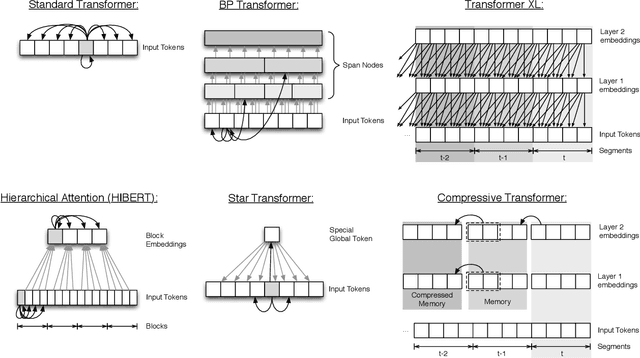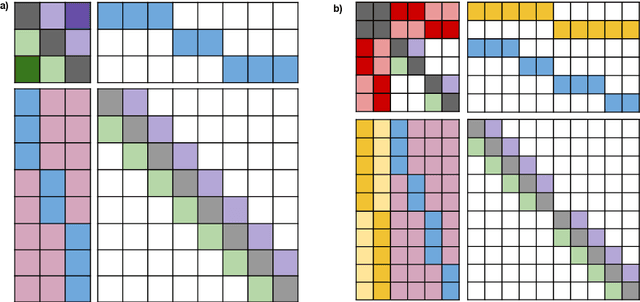Philip Pham
ReadTwice: Reading Very Large Documents with Memories
May 11, 2021



Abstract:Knowledge-intensive tasks such as question answering often require assimilating information from different sections of large inputs such as books or article collections. We propose ReadTwice, a simple and effective technique that combines several strengths of prior approaches to model long-range dependencies with Transformers. The main idea is to read text in small segments, in parallel, summarizing each segment into a memory table to be used in a second read of the text. We show that the method outperforms models of comparable size on several question answering (QA) datasets and sets a new state of the art on the challenging NarrativeQA task, with questions about entire books. Source code and pre-trained checkpoints for ReadTwice can be found at https://goo.gle/research-readtwice.
OmniNet: Omnidirectional Representations from Transformers
Mar 01, 2021



Abstract:This paper proposes Omnidirectional Representations from Transformers (OmniNet). In OmniNet, instead of maintaining a strictly horizontal receptive field, each token is allowed to attend to all tokens in the entire network. This process can also be interpreted as a form of extreme or intensive attention mechanism that has the receptive field of the entire width and depth of the network. To this end, the omnidirectional attention is learned via a meta-learner, which is essentially another self-attention based model. In order to mitigate the computationally expensive costs of full receptive field attention, we leverage efficient self-attention models such as kernel-based (Choromanski et al.), low-rank attention (Wang et al.) and/or Big Bird (Zaheer et al.) as the meta-learner. Extensive experiments are conducted on autoregressive language modeling (LM1B, C4), Machine Translation, Long Range Arena (LRA), and Image Recognition. The experiments show that OmniNet achieves considerable improvements across these tasks, including achieving state-of-the-art performance on LM1B, WMT'14 En-De/En-Fr, and Long Range Arena. Moreover, using omnidirectional representation in Vision Transformers leads to significant improvements on image recognition tasks on both few-shot learning and fine-tuning setups.
Long Range Arena: A Benchmark for Efficient Transformers
Nov 08, 2020



Abstract:Transformers do not scale very well to long sequence lengths largely because of quadratic self-attention complexity. In the recent months, a wide spectrum of efficient, fast Transformers have been proposed to tackle this problem, more often than not claiming superior or comparable model quality to vanilla Transformer models. To this date, there is no well-established consensus on how to evaluate this class of models. Moreover, inconsistent benchmarking on a wide spectrum of tasks and datasets makes it difficult to assess relative model quality amongst many models. This paper proposes a systematic and unified benchmark, LRA, specifically focused on evaluating model quality under long-context scenarios. Our benchmark is a suite of tasks consisting of sequences ranging from $1K$ to $16K$ tokens, encompassing a wide range of data types and modalities such as text, natural, synthetic images, and mathematical expressions requiring similarity, structural, and visual-spatial reasoning. We systematically evaluate ten well-established long-range Transformer models (Reformers, Linformers, Linear Transformers, Sinkhorn Transformers, Performers, Synthesizers, Sparse Transformers, and Longformers) on our newly proposed benchmark suite. LRA paves the way towards better understanding this class of efficient Transformer models, facilitates more research in this direction, and presents new challenging tasks to tackle. Our benchmark code will be released at https://github.com/google-research/long-range-arena.
Big Bird: Transformers for Longer Sequences
Jul 28, 2020



Abstract:Transformers-based models, such as BERT, have been one of the most successful deep learning models for NLP. Unfortunately, one of their core limitations is the quadratic dependency (mainly in terms of memory) on the sequence length due to their full attention mechanism. To remedy this, we propose, BigBird, a sparse attention mechanism that reduces this quadratic dependency to linear. We show that BigBird is a universal approximator of sequence functions and is Turing complete, thereby preserving these properties of the quadratic, full attention model. Along the way, our theoretical analysis reveals some of the benefits of having $O(1)$ global tokens (such as CLS), that attend to the entire sequence as part of the sparse attention mechanism. The proposed sparse attention can handle sequences of length up to 8x of what was previously possible using similar hardware. As a consequence of the capability to handle longer context, BigBird drastically improves performance on various NLP tasks such as question answering and summarization. We also propose novel applications to genomics data.
Fair Hierarchical Clustering
Jun 19, 2020



Abstract:As machine learning has become more prevalent, researchers have begun to recognize the necessity of ensuring machine learning systems are fair. Recently, there has been an interest in defining a notion of fairness that mitigates over-representation in traditional clustering. In this paper we extend this notion to hierarchical clustering, where the goal is to recursively partition the data to optimize a specific objective. For various natural objectives, we obtain simple, efficient algorithms to find a provably good fair hierarchical clustering. Empirically, we show that our algorithms can find a fair hierarchical clustering, with only a negligible loss in the objective.
ETC: Encoding Long and Structured Data in Transformers
Apr 21, 2020



Abstract:Transformer-based models have pushed the state of the art in many natural language processing tasks. However, one of their main limitations is the quadratic computational and memory cost of the standard attention mechanism. In this paper, we present a new family of Transformer models, which we call the Extended Transformer Construction (ETC), that allows for significant increases in input sequence length by introducing a new global-local attention mechanism between a global memory and the standard input tokens. We also show that combining global-local attention with relative position encodings allows ETC to handle structured data with ease. Empirical results on the Natural Questions data set show the promise of the approach.
 Add to Chrome
Add to Chrome Add to Firefox
Add to Firefox Add to Edge
Add to Edge